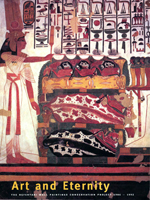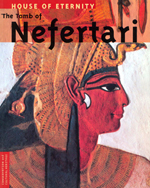Assmann, Jan (2010) Globalization, Universalism, and the Erosion of Cultural Memory. In: Assmann, Aleida and Conrad, Sebastian (Hrsgg.): Memory in a Global Age. Discourses, Practices and Trajectories, Palgrave Macmillan Memory Studies. New York 2010, pp. 121-137.
Assmann, Jan (2010) Mythen der Unvollkommenheit, Mysterien der Vervollkommnung. In: Assmann, Aleida and Assmann, Jan (Hrsgg.): Vollkommenheit. München 2010, pp. 65-81.
Assmann, Jan (2010) Politik und Religion. Altägyptische und biblische Ausprägungen eines aktuellen Problems. In: Assmann, J. and Strohm, H. (Hrsgg.): Herrscherkult und Heilserwartung. München 2010, pp. 83-105.
Assmann, Jan (2009) Der Mensch - das Tier, das zu viel weiß. Altorientalische Mythen zum Thema der menschlichen Endlichkeit. In: Schmidinger, Heinrich and Sedmak, Clemens (Hrsgg.): Der Mensch – ein Mängelwesen? Endlichkeit – Kompensation – Entwicklung. Darmstadt 2009, pp. 99-114.
Assmann, Jan (2009) Der Mythos des Gottkönigs im Alten Ägypten. In: Schmitz, Christine and Bettenworth, Anja (Hrsgg.): Mensch – Heros – Gott. Weltentwürfe und Lebensmodelle im Mythos der Vormoderne. Wiesbaden 2009, pp. 11-25.
Assmann, Jan (2009) Die Piye(Pianchi)Stele: Erzählung als Medium politischer Repräsentation. In: Roeder, H. (Hrsg.): Das Erzählen in frühen Hochkulturen I. Der Fall Ägypten. München 2009, pp. 221-236.
Assmann, Jan (2009) Konstellative Anthropologie. Zum Bild des Menschen im alten Ägypten. In: Janowski,, Bernd and Liess, Kathrin (Hrsgg.): Der Mensch im Alten Israel. Neue Forschungen zur alttestamentlichen Anthropologie. Freiburg 2009, pp. 95-120.
Assmann, Jan (2008) Communicative and Cultural Memory. In: Erll, Astrid and Nünning, Ansgar (Hrsgg.): Cultural Memory Studies. An International and Interdisciplinary Handbook. Berlin ; New York 2008
Assmann, Jan (2008) Sakralkönigtum und Gemeinschaftskunst. Der Alte Orient und das Politische. In: Junge, Kay and Šuber, Daniel and Gerber, Gerold (Hrsgg.): Erleben Erleiden Erfahren. Die Konstitution sozialen Sinns jenseits instrumenteller Vernunft. Bielefeld 2008, pp. 357-371.
Assmann, Jan (2007) Das Heil: Religiöse Zukunftsvorstellungen im kulturellen Gedächtnis. In: Thomas, G. and Schüle, A. (Hrsgg.): Gegenwart des lebendigen Christus. Leipzig 2007, pp. 463-478.
Assmann, Jan (2007) Der Schrecken Gottes im Alten Ägypten. In: Lubs, Sylke (Hrsg.): Behutsames Lesen. Alttestamentliche Exegese im interdisziplinären Methodendiskurs. Leipzig 2007, pp. 153-165.
Assmann, Jan (2007) Gott und die Götter. In: Palmer, Gesine (Hrsg.): Fragen nach dem einen Gott. Tübingen 2007, pp. 29-51.
Assmann, Jan (2007) Kunst und Rituale: Mozarts Zauberflöte. In: Michaels, Axel (Hrsg.): Die neue Kraft der Rituale. Heidelberg 2007, pp. 87-116.
Assmann, Jan (2006) Das Sendungsbewusstsein der Hatschepsut. In: Moers, Gerald (Hrsg.): jn.t dr.w – Festschrift für Friedrich Junge. Göttingen 2006, pp. 59-72.
Assmann, Jan (2006) Der Ka als Double. In: Stoichita, V. (Hrsg.): Das Double. Wiesbaden 2006, pp. 59-78.
Assmann, Jan (2006) Der Mann Moses und die monotheistische Religion (1939 1934-38]). In: Lohmann, Hans-Martin and Pfeiffer, Joachim (Hrsgg.): Freud Handbuch. Leben – Werk – Wirkung. Stuttgart, Weimar 2006, pp. 181-187.
Assmann, Jan (2006) Form as a Mnemonic Device: Cultural Texts and Cultural Memory. In: Horsley, Richard A. and Draper, Jonathan A. and Foley, John Miles (Hrsgg.): Performing the Gospel. Orality, Memory, and Mark. Essays dedicated to Werner Kelber. Fortress Press, Minneapolis 2006, pp. 67-82.
Assmann, Jan (2006) Gesetz, Gewalt und Monotheismus. In: Theologische Zeitschrift , 62 (2006), Nr. 4. pp. 475-486.
Assmann, Jan (2006) Kulte und Religionen. Merkmale primärer und sekundärer Religion(serfahrung) im Alten Ägypten. In: Wagner, Andreas (Hrsg.): Primäre und sekundäre Religion als Kategorie der Religionsgeschichte des Alten Testaments. Berlin ; New York 2006, pp. 269-280.
Assmann, Jan (2006) Schönheit und Gerechtigkeit. »... man gedenkt seiner wegen der Tugend«. In: Schönheit im Alten Ägypten. Sehnsucht nach Vollkommenheit. Hildesheim 2006, pp. 12-22.
Assmann, Jan (1988) Egypte ancienne - la mémoire monumentale. In: Gignoux, Ph. (Hrsg.): La commémoration, Colloque du Centenaire, Bibliothèque des Hautes Études, Sciences religieuses, Vol.XCI. Louvain-Paris 1988, pp. 47-56.
Assmann, Jan (1988) Ikonographie der Schönheit im alten Ägypten. In: Stemmler, Th. (Hrsg.): Schöne Frauen - schöne Männer: literarische Schönheitsbeschreibungen. 2.Kolloquium der Forschungsstelle für europäische Literatur des Mittelalters. Mannheim 1988, pp. 13-32.
Assmann, Jan (1988) Im Schatten junger Medienblüte. Ägypten und die Materialität des Zeichens. In: Gumbrecht, H.U. and Pfeiffer, K.L. (Hrsgg.): Materialität der Kommunikation. Frankfurt 1988, pp. 141-160.
Assmann, Jan (1988) Stein und Zeit. Das »monumentale« Gedächtnis der altägyptischen Kultur. In: Kultur und Gedächtnis. Frankfurt 1988, pp. 87-114.
Assmann, Jan (1987) Hierotaxis. Textkonstitution und Bildkomposition in der altägyptischen Kunst und Literatur. In: Osing, J. and Dreyer, G. (Hrsgg.): Form und Mass. Beiträge zu Sprache, Literatur und Kunst des alten Äypten. Festschrift für Gerhard Fecht, Wiesbaden. Wiesbaden 1987, pp. 18-42.
Assmann, Jan (1987) Priorität und Interesse. Das Problem der Ramessidischen Beamtengräber. In: Problems and Priorities in Egyptian Archaeology. London 1987, pp. 31-41.
Assmann, Jan (1986) Arbeit am Polytheismus. In: Stietencron, H.v. (Hrsg.): Theologen und Theologien in verschiedenen Kulturkreisen. Düsseldorf 1986, pp. 46-69.
Assmann, Jan (1986) Viel Stil am Nil? Altägypten und das Problem des Kulturstils. In: Gumbrecht, H.U. and Pfeifer, K.L. (Hrsgg.): Stil. Geschichten und Funktionen eines kulturwissenschaftlichen Diskurselements. Frankfurt 1986, pp. 519-537.
Assmann, Jan (1985) Die Entdeckung der Vergangenheit. Innovation und Restauration in der ägyptischen Literaturgeschichte. In: Gumbrecht, H.U. and Link-Heer, U. (Hrsgg.): Epochenschwellen und Epochenstrukturen im Diskurs der Literatur- und Sprachhistorie. Frankfurt 1985, pp. 484-499.
Assmann, Jan (1985) Gibt es eine "Klassik" in der ägyptischen Literaturgeschichte? Ein Beitrag zur Geistesgeschichte der Ramessidenzeit. In: W. Röllig (Hrsg) Vom 21. bis 25. März 1983 in Tübingen. XII. Deutscher Orientalistentag. 1985, pp. 35-52. (Zeitschrift der Deutschen Morgenländischen Gesellschaft: Supplement ; 6)
Assmann, Jan (1984) Das Grab mit gewundenem Abstieg. Zum Typenwandel des Privat-Felsgrabes im Neuen Reich. In: Mitteilungen des Deutschen Archäologischen Instituts, Abteilung Kairo, 40 (1984), pp. 277-290.
Assmann, Jan (1984) Politik zwischen Ritual und Dogma. Spielräume politischen Handelns im pharaonischen Ägypten. In: Saeculum, 35 (1984), pp. 97-114.
Assmann, Jan (1983) Das Dekorationsprogramm der königlichen Sonnenheiligtümer des Neuen Reiches nach einer Fassung der Spätzeit. In: Zeitschrift für ägyptische Sprache und Altertumskunde, 110 (1983), pp. 91-98.
Assmann, Jan (1983) Das Doppelgesicht der Zeit im altägyptischen Denken. In: Mohler, A. and Peisl, A. (Hrsgg.): Die Zeit (Schriften der C.F.v. Siemens-Stiftung Nr.6). München 1983, pp. 189-223.
Assmann, Jan (1983) Die Gestalt der Zeit in der ägyptischen Kunst. In: 5000 Jahre Ägypten. Genese und Permanenz pharaonischer Kunst. Heidelberg 1983, pp. 11-32.
Assmann, Jan (1983) Die Rubren der Sinuhe-Erzählung. In: Görg, M. (Hrsg.): Fontes atque Pontes: Eine Festgabe für Hellmut Brunner. Bamberg 1983, pp. 18-41.
Assmann, Jan (1983) Schrift, Tod und Identität. Das Grab als Vorschule der Literatur im alten Ägypten. In: Schrift und Gedächtnis. Archäologie der literarischen Kommunikation I. München 1983, pp. 64-93.
Assmann, Jan (1982) Die Zeugung des Sohnes. Bild, Spiel, Erzählung und das Problem des ägyptischen Mythos. In: Assmann, J. and Burkert, W. and Stolz, F. (Hrsgg.): Funktionen und Leistungen des Mythos. Drei altorientalische Beispiele (Orbis Biblicus et Orientalis 48). Fribourg; Göttingen 1982, pp. 13-61.
Assmann, Jan (1982) Ägyptologie als verstehende Wissenschaft. Über die hermeneutisohe Funktion des interdisziplinären Gesprächs. In: Göttinger Miszellen, 55 (1982), pp. 13-19.
Assmann, Jan (1980) Die 'Loyalistische Lehre' Echnatons. In: Studien zur altägyptischen Kultur, 8 (1980), pp. 1-32.
Assmann, Jan (1980) Grundstrukturen der ägyptischen Gottesvorstellungen. In: Biblische Notizen, 11 (1980), pp. 46-62.
Assmann, Jan (1979) Harfnerlied und Horussöhne. Zwei Blöcke aus dem verschollenen Grab des Bürgermeisters Amenemhet (Theben Nr.163) im Britischen Museum. In: The Journal of Egyptian Archaeology, 65 (1979), pp. 54-77.
Assmann, Jan (1979) Primat und Transzendenz. Struktur und Genese der ägyptischen Vorstellung eines 'Höchsten Wesens'. In: Westendorf, W. (Hrsg.): Aspekte der spätägyptischen Religion. Wiesbaden 1979, pp. 7-42. (Göttinger Orientforschungen ; IV.9)
Assmann, Jan (1977) Das ägyptische Zweibrüdermärchen (Papyrus d'Orbiney). In: Zeitschrift für ägyptische Sprache und Altertumskunde, 104 (1977), pp. 1-25.
Assmann, Jan (1977) Die Verborgenheit des Mythos in Ägypten. In: Göttinger Miscellen, 25 (1977), pp. 7-43.
Assmann, Jan (1977) Fest des Augenblicks - Verheißung der Dauer. Die Kontroverse der ägyptischen Harfnerlieder. In: Fragen an die altägyptische Literatur (Studien zum Gedenken an Eberhard Otto). Wiesbaden 1977, pp. 55-84.
Assmann, Jan (1976) Das Bild des Vaters im Alten Ägypten. In: Bornkamm, G. and Gadamer, H.G. (Hrsgg.): Das Vaterbild in Mythos und Geschichte. Stuttgart 1976, pp. 12-49.
Assmann, Jan (1974) Der literarische Text im Alten Ägypten. Versuch einer Begriffsbestimmung. In: Orientalistische Literaturzeitung, 69 (1974), pp. 117-126.
Assmann, Jan (1974) Ägyptologie und Linguistik. In: Göttinger Miszellen, 11 (1974), pp. 59-76.
Assmann, Jan (1973) Neith spricht als Mutter und Sarg. In: Mitteilungen des Deutschen Archäologischen Instituts, Abteilung Kairo, 28 (1973), Nr. 2. pp. 115-139.
Assmann, Jan (1973) Wort und Text. Entwurf einer semantischen Textanalyse. In: Göttinger Miszellen, 6 (1973), pp. 9-31.
Assmann, Jan (1972) Die Inschrift auf dem äußeren Sarkophagdeckel des Merenptah. In: Mitteilungen des Deutschen Archäologischen Instituts, Abteilung Kairo, 28 (1972), Nr. 1. pp. 47-73.
Assmann, Jan (1972) Die „Häresie" des Echnaton: Aspekte der Amarna-Religion. In: Saeculum, 23 (1972), pp. 109-126.
Assmann, Jan (1971) Zwei Sonnenhymnen der späten XVIII. Dynastie in thebanischen Gräbern der Saitenzeit. In: Mitteilungen des Deutschen Archäologischen Instituts, Abteilung Kairo, 27 (1971), Nr. 1. pp. 1-33.
Assmann, Jan (1968) Arbeiten im Grab des Basa. In: Mitteilungen des Deutschen Archäologischen Instituts, Abteilung Kairo, 23 (1968), pp. 20-25.
Assmann, Jan (1963) Zur Baugeschichte der Königsgruft von Sidon. In: Archäologischer Anzeige, (1963), pp. 690-716. |
|











